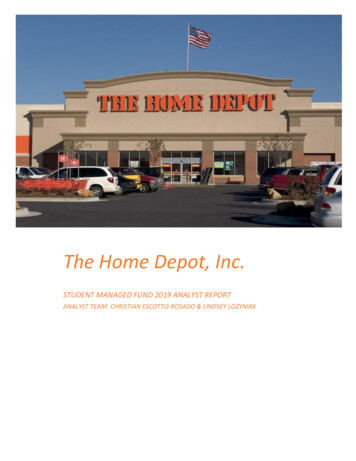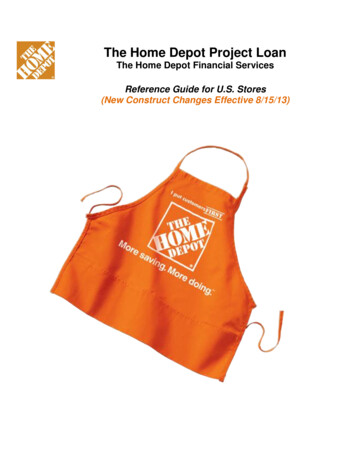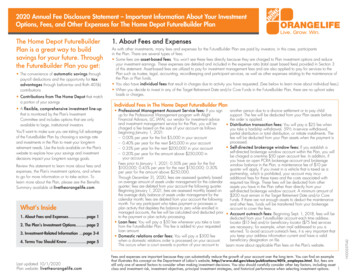
Transcription
The Home Depot, Inc.STUDENT MANAGED FUND 2019 ANALYST REPORTANALYST TEAM: CHRISTIAN ESCOTTO-ROSADO & LINDSEY LOZYNIAK
Table of ContentsBasis for Recommendation . 2Business overview . 3Industry Analysis . 4Industry Analysis . 4Competitive Analysis . 4Porter’s Five Forces. 5Competitive Advantages . 5Investment Thesis . 6Wide Economic Moat . 6One Home Depot . 6Recent Acquisitions. 7Current Standing Within the Industry . 7Valuation . 8Risks . 8Corporate Social Responsibility . 9Management . 10Conclusion . 10Appendix . 6DCF Model . 6Merchandise Departments . 6Consolidated Financial Statements . 61 P a g e
The Home Depot, Inc. (NYSE: HD)January 31, 2019NYSE: HDRecommendation: BUYTarget Price: 224.91Current Price: 179.69Market Cap: 203BTTM P/E: 19.39xEPS: 9.21Dividend Yield: 2.29%52 Week High: 215.4352 Week Low: 158.09Industry: Home Improvement RetailBasis for RecommendationWe recommend a BUY rating for The Home Depot based on their wide economicmoat, strong growth catalysts, and top position in the Home Improvementindustry. Home Depot has experienced strong revenue growth over the past fiveyears, and it has strong catalysts, such as the One Home Depot Initiative, thatshould continue to drive revenue growth. Home Depot is the largest company inthe Home Improvement industry, comprising 47% of the market share. They havestrong bargaining power over their broad network of suppliers and are able toprovide a low-cost advantage to their customers, which encourages their loyalty.Many traditional brick and mortar stores are struggling to compete with onlineretailers such as Amazon. The Home Depot, however, is resistant to the threat ofe-commerce because they sell products that are largely cost ineffective for ecommerce giants to sell and have developed their own e-commerce distributionchannel.2 P a g e
BUSINESS OVERVIEWThe Home Depot Inc. was founded in 1978 and is the world’s largest home improvement retailer. They operate2,284 stores across North America with locations in The United States, Puerto Rico, The Virgin Islands, Guam,Canada, and Mexico. Stores average approximately 128,000 square feet, with sales per square foot averaging 417, and an average ticket of 63. In addition to their stores, The Home Depot operates a network of distributionand fulfilment centers, as well as e-commerce sites. The Home Depot offers a wide selection of homeimprovement products, lawn and garden products, and décor products as well as numerous services such and tooland equipment rental and home improvement installation services (Appendix B).The Home Depot’s three major customer segments, defined below, are comprised of DIY customers (18.2%) andProfessionals plus “Do it For Me” customers (81.8%)Do-It-Yourself (DIY): Primarily customers who own homes and complete their own projects and installations.Home Depot’s associates help provide product and project expertise through in-store interactions, online media,and other resources. The Home Depot also offers a number of workshops to build a relationship with thesecustomers.Do-It-For-Me (DIFM): Primarily customers who are own homes and engage with pros to complete home projectsand installation. The Home Depot offers a variety of installation services to these customers available for purchaseboth in-store. Installation programs include categories such as: flooring, windows, countertops, furnaces, andcentral air systems.Professionals (PROS): “Professionals” include: professional contractors/home remodelers, general contractors,handymen and property managers, plumbers, electricians, and painters. These customers build, renovate, andmaintain: Residential, hospitality, and commercial propertiesSingle and multi-family homes3 P a g e
Commercial, education, and healthcare facilitiesGovernment and office buildingsINDUSTRY ANALYSISIndustry AnalysisThe Home Improvement industry is moderately sensitive to changes in macroeconomic factors such as the healthof the overall United States economy and US housing starts. According to consensus estimates, the USunemployment rate will remain relatively low and GDP per-capita is poised to grow at 3.2% per year over the nextfour years. These statistics contribute to our positive outlook for the home improvement sector as they signal thatconsumers will be able to continue to generate income and have discretionary funds that could be spent on homeimprovement projects.The customer base of Home Depot and Lowe’s, the top two home improvement retailers, has historically beensplit between Professionals and DIY customers. However, there is a growing segment of customers referred to asDo-It-For-Me (DIFM) customers, who choose to have a professional complete their home projects andinstallations. There is a consensus that the DIFM customer segment will continue to grow as the baby boomergeneration, that has predominantly been DIY customers, become more willing to pay a premium for installationservices.Competitive Analysis4 P a g e
The US Home Improvement industry is commonly referred to as a duopoly between Lowe’s and Home Depot. Thetwo titans account for 78% of the industry’s market share with Home Depot controlling 47% of the market andLowe’s controlling 31%. In reality, the business model and products of both companies are extremely similar.Despite similar business models, The Home Depot has managed to gain a lead in market share and we believe thiswill remain the case due to Home Depot’s value, culture, and innovation.Porter’s Five ForcesAfter conducting a Porter’s Five Forces analysis on both Home Depot and Lowe’s, we concluded the following:Bargaining Power - Consumer: We determined a moderate level threat. Consumers face a nonexistent cost ofswitching between competitors in the Home Improvement industry, which gives them leverage over companiesand an ability to speak with their wallets. The Home Depot combats this threat by providing customers witheveryday low prices and a robust portfolio of exclusive brands.Bargaining Power - Suppliers: We determined a very low-level threat. Due to Home Depot’s size, they possess alarge amount of leverage over their suppliers. This allows Home Depot to drive aggressive deals with suppliers andgenerate value that can be passed on to customers.Threat of Substitutes: We determined that this is the biggest threat to Home Depot. As outlined in the BargainingPower of Consumers, there is little to no cost of switching between companies to consumers allowing consumersthe possibility of “cherry picking” what products to buy from which store. In addition to great prices, The HomeDepot responds to this threat by instilling loyalty in their customers and diversifying themselves through a focus onculture and customer satisfaction.Threat of new entrants: We determined a very low risk level. While it wouldn’t be impossible to start up a chain ofhome improvement stores, we believe it would be near impossible for a new competitor to reach the scale ofLowe’s and Home Depot, due to the established brand loyalty and supplychain network that Home Depot and Lowe’s have spent decades creating.Competitive Rivalry: Lastly, we determined that competitive rivalry is amoderate level threat. The Home Improvement industry is a maturemarket in which Home Depot is already the industry leader. There aremultiple factors that lead us to conclude that The Home Depot will remainthe industry leader well into the future and they are outlined in thecompetitive advantages section.Competitive AdvantagesThe Home Depot is focused on improving their supply chain, increasingtheir exposure to customers, and instilling customer loyalty by providingamazing value. In order to improve their supply chain and exposure tocustomers, Home Depot has started an initiative named One Home DepotFigure 15 P a g e
The Home Depot quantitatively outclasses Lowe’s in several comparative metrics. Referring to figure 1, one keytakeaway is the fact the market is willing to pay a higher premium per dollar of Home Depot earnings compared toLowe’s. Home Depot’s higher P/E Ratio is indicative of the overall market’s belief that Home Depot’s growthpotential is higher than that of Lowe’s. Two other key statistics from figure 1 are the average ticket number andthe total transactions per year. Lowe’s has a slightly higher average ticket number, beating Home Depot’s averageticket by 9, but The Home Depot produces 625 million more transactions than Lowe’s in a year while only having151 more stores than Lowe’s.INVESTMENT THESISWide Economic MoatAn economic moat comes from a company’s ability to diversify itself and become unique to the point that it is nearimpossible to recreate. The Home Depot’s wide economic moat is attributed to their bargaining power oversuppliers. Due to their scale, The Home Depot is able to cut immense deals with their suppliers. The Home Depot’ssuppliers need Home Depot’s business more than Home Depot needs theirs: The Home Depot deals with a broadnetwork of suppliers and offer account for a large portion of their suppliers revenues. The leverage that HomeDepot has over suppliers allows for them to demand discounts on products, creating value that can then be passedon to Home Depot’s customers in the form of everyday low prices that can only be matched by Lowe’s.Another aspect of The Home Depot’s wide economic moat is that they are resilient o the threat of e-commerce;They’re “Amazon-proof”. Most of the products that Home Depot offers, such as lumber, are cost inefficient for ecommerce giants like Amazon to ship. The Home Depot also has an answer for those products that can be easilysold online, and that’s their One Home Depot initiative. With One Home Depot, Home Depot gains a competitiveadvantage against general e-commerce companies by creating an ecosystem to benefit the customer. This ecosystem not only addresses Home Depot’s e-commerce problems, but also boosts customer satisfaction andincentivizes customer loyalty which leads to growth for the company.One Home DepotOne Home Depot is the name of Home Depot’s 11 billion strategy to drive growth. The initiative was announcedin late 2017 and aims to invest in their stores, associates, digital experience, and supply chain. The goal of thisinvestment is to:·Connect associates to customer needs·Expand their interconnected experiences: stores to online,online to stores·Connect products and services to customer needs·Connect product to shelf, site and customer·Innovate their business model and value chain6 P a g e
The One Home Depot initiative and the investment is already yielding results in Home Depot stores. One technologydeveloped as part of the initiative is the improved Home Depot mobile application. The app now supports functionssuch as in store maps that can lead you exactly to the product you are looking for. The app can also tell you aheadof time whether the product you’re looking for is in stock and how much of the product is available. Another pillarof the One Home Depot initiative is: “to create the fastest and most efficient delivery capabilities in homeimprovement” (Home Depot, 2017). The Home Depot is working towards this by enhancing their inventorymanagement system to leverage the benefits of their 200 distribution centers and over 2,000 stores.Recent AcquisitionsThe Home Depot has made a number of acquisitions in order to add to their competitive edge. Management hasshown that they are constantly evaluating their strengths and weaknesses and evaluating how to best improve thecompany, whether it be through developing a “home grown” solution, such as One Home Depot, or throughacquiring a company that has the specific skill set that management believes Home Depot needs. The following arethree acquisitions that we believe will continue to develop Home Depot’s strengths:The Company Store - Acquired in 2017 for 109 Million, The Company Store was a leader in online textiles and homedecor products. This acquisition has allowed Home Depot to greatly increase their decor offerings while alsoallowing Home Depot to leverage the company’s web presence.Compact Power Equipment - Compact Power Equipment was acquired in 2017 for 265 Million and was anequipment rental and maintenance company. This acquisition was aimed to boost customer satisfaction,particularly the pros segment of customers, and helped Home Depot enhance their equipment and tool rentalofferings.Interline Brands - Interline Brands was a big acquisition in 2015. The company was acquired for 1.6 Billion and wasa large-scale distributor of maintenance products. This acquisition has been widely accepted as a success due to itincreasing Home Depot’s maintenance, repairs and operation supplies capabilities. Interline Brands also increasedHome Depot’s last mile delivery capabilities.Current Standing Within the IndustryWe believe that Home Depot is well positioned for growth. In the Competitive Advantages section, we mentionedseveral reasons why we believe Home Depot to be a better company than Lowe’s. In addition to those quantitativefactors there are qualitative factors that further support our theory.In late 2018, Lowe’s announced that they would be closing 51 stores. Part of thejustification of these closures were due to the fact that most of those Lowe’swere within a ten-mile radius of another Lowe’s, but it was a negative signalnonetheless. Lowe’s has also started to take lessons from The Home Depot.Lowe’s current CEO Marvin Ellison was a high-ranking officer at Home Depot forover 12 years and has openly stated that he would like to implement strategiesfrom the Home Depot play book wherever possible. We believe this to beanother weak signal because it shows that Lowe’s is effectively playing catch upwith Home Depot, and if their main focus is to catch up and achieve what Home7 P a g e
Depot has already done, it shows that they are not innovating in a way that would surpass what Home Depot iscurrently doing.VALUATIONFigure 2 shows a summary of our scenarios and what weight was assigned to each scenario. On the date of ouroriginal stock pitch, the price of Home Depot was 184.64 per share. Using our target price of 224.91, wecalculated the margin of safety on this investment to be about 22%.Our full DCF model can be found in Appendix A. For our projections we used a combination of consensusprojections and our own opinions to arrive at expected growth rates and ratios. For revenue projections we beganto decelerate revenue growth which was in line with expert consensus.Figure 2However, after 2022 we begin to see a rebound in the revenue growth rate after dropping to 3.3%. The thoughtprocess behind this rebound is to be in line with the overall economic cycle.Given our prior modeling experience, we realize the impact that the perpetual growth rate can have on our finaltarget price. We wanted to take a conservative estimate for this growth rate, even in our base case. To formulateour perpetual growth rate, we started with the base being the US real GDP growth rate. Our long-term expectationis that the US real GDP will grow at a minimum of 2.5% well into the future. With that as a base we also estimatedthe Home Depot will grow its revenue at least .5% faster than the US grows its real GDP. Adding the two gives usour terminal growth rate of 3% in a base case and then we added/subtracted 30 basis points for bull/base cases.RISKSWe have identified the following risks that could negatively impact Home Depot’s operations, ability to generate orincrease revenue, and our investment thesis:Failure to Properly Implement Initiatives:Home Depot has made significant investments in their One Home Depot initiative and recent acquisitions. There isa risk of short-term disruption of operations as a result of the implementation of these initiatives. There is also arisk that these initiatives could fail or fail to provide their intended benefit.8 P a g e
Technology Failure:Failure of information technology systems, customer facing technology, or supply chain could impair Home Depot’soperations, interconnected retail strategy, and e-commerce sales channel.Failure to Attract and Retain Qualified AssociatesHome Depot’s ability to employ qualified associates who can provide industry-leading customer service is criticalto maintain their status as the #1 home improvement retailer. Additionally, external factors including wage andinsurance costs could affect their ability to control labor costs.Failure to AdaptThe Home Improvement industry is highly competitive and concentrated. The Home Depot may not be able tomaintain its market share if it cannot adapt to changing customer demands, needs, and trends. Additionally, strongcompletion may have an adverse effect on Home Depot’s pricing power.CORPORATE SOCIAL RESPONSIBILITYThe Home Depot has established 3 pillars for their ESG strategy: Focus on People, Strengthen Communities, andoperate sustainably. The company is focused on reducing their environmental impact by operating sustainably andselling products that meet and exceed environmental standards. The environmental non-profit CDP ranked HomeDepot “A” on its Climate Change List for their actions to reduce carbon emissions and mitigate climate risks. Inaddition to being environmentally conscious, The Home Depot is focused on supporting veterans, providingdisaster relief, and training tradespeople. 35,000 of The Home Depot’s employees are U.S. veterans or reservists, and they have committed 500 millionto veteran causes by 2025They have committed 50 million to train 20,000 tradespeople over the next ten yearsIn 2017, they committed over 3 million to disaster relief after hurricanes Harvey, Maria, and Irma9 P a g e
ManagementConclusionIn conclusion, we believe that The Home Depot is the most attractive investment opportunity in the HomeImprovement industry. We have analyzed The Home Depot, Inc. using qualitative and quantitative approaches andafter modeling our expectations of the company we found a positive margin of safety, indicating that the companyis currently undervalued. We have a positive outlook for the industry as a whole given our economic outlook, andwe strongly believe that Home Depot will outperform Lowe’s. Our investment thesis for investing in this industryboils down to the Home Improvement industry having a wide economic moat that protects it from fierce ecommerce competition with the likes of Amazon.After choosing the Home Improvement industry, we identified that the question becomes whether to invest inHome Depot, or Lowe’s. One reason behind our belief that Home Depot is a more attractive investment thanLowe’s is because of their current place within the industry. Home Depot outperforms Lowe’s in most quantitativemetrics. From our qualitative analysis, we concluded that Home Depot is innovating while Lowe’s is simply playingcatch up. The One Home Depot initiative is a great example of Home Depot’s innovative mindset. It shows thatHome Depot is focused on the maximizing efficiency and customer satisfaction. The Home Depot is a truly nimblecompany that is well positioned to continue dominating in an industry that will continue to grow, and that is whywe have issued a BUY recommendation.10 P a g e
Appendix A: DCF .54%21,680.9817.20%45,593.9434.58%22,651.9417.18%( ) Operating Income% Margin(-) Tax on Operating Income% Tax ( ) NOPAT% .5212.83%16,977.0912.88%( ) Depreciation & Amortization% of 2,874.342.18%(-) Capital Expenditure% of 6)-0.11%(158.22)-0.12%( ) Changes in Net Long Term Deferred Tax Liabilities% of 25,816.3519.58%Revenue (Estimate Comparable)% YoY Growth(-) Cost of Revenue% of Revenue( ) Gross Profit% Margin(-) Operating Expenses/Income% of Revenue(-) Changes in Net Working Capital% of Revenue( ) Free Cash Flow% Margin6,022.458.06%% of the Free Cash Flow to be discountedPeriod for Discount Factor (Mid-Year Convention)Discount FactorPresent Value of Free Cash Flow (5 Years)8.40%EBITDA9,547.00% 015.41%15,400.0016.28%16,743.0016.59%11 P a g e16,058.3024,729.41
Appendix B: Merchandise Segments as % of RevenueMERCHANDISE DEPARTMENTS AS % OF REVENUEMillwork, 5%Décor, 3%Indoor Garden,10%Lighting, 4%Appliances, 8%Electrical, 5%Hardware, 6%Paint, 8%Outdoor Garden,7%Lumber, 8%Flooring, 7%BuildingMaterials, 7%Tools, 7%Plumbing, 7%Kitchen and Bath,7%12 P a g e
Appendix C: 2018 Consolidated Financial Statements13 P a g e
14 P a g e
15 P a g e
The Home Depot quantitatively outclasses Lowe’s in several comparative metrics. Referring to figure 1, one key takeaway is the fact the market is willing to pay a higher premium per dollar of Home Depot earnings compared to Lowe’s. Home Depot’s higher P/E Ratio is indicative of the overall










